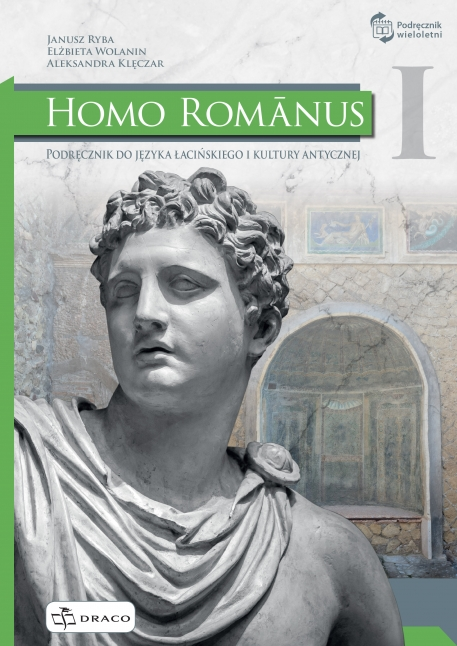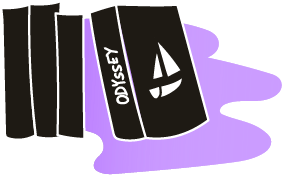Title of the resource
Title of the resource in english
Publisher
Wydawnictwo Draco
Original language
Target and Age Group
Upper-secondary schools (16-18 years old)
Link to resource
Accessed on 25 August, 2020
Author of the Entry:
Marta Pszczolińska, University of Warsaw, m.pszczolinska@al.uw.edu.pl
Peer-reviewer of the Entry:
Elżbieta Olechowska, University of Warsaw, elzbieta.olechowska@gmail.com
Second Peer-reviewer of the Entry:
Ayelet Peer, Bar- Ilan University, ayelet.peer@biu.ac.il
Janusz Ryba
Janusz Ryba – is an Assistant Professor at the Institute of Classical Philology at the Jagiellonian University of Kraków and a classic languages teacher at a high school. His research interests cover the history of teaching of classical languages in the Polish education system and methodology of teaching classical languages. He is also interested in the problems associated with the classical educational model in the Polish school system, state policy in that area and their impact on the teaching of classical languages.
source: ifk.filg.uj.edu.pl (accessed: October 31, 2019)

Courtesy of the author
Elżbieta Wolanin
Elżbieta Wolanin is a Latin language teacher. She has taught a course of Latin and ancient culture for examiners conducting final graduation assessments at high school, led a nationwide exam grading team (and graded exams herself), and designed resources to be used in workshops on excellence in grading and formulating exam questions for teachers. As an expert appointed by the Ministry of National Education, she co-created the national core curriculum for Latin and the ancient culture. She is the author of Ad astra - a set of exercises for high school students preparing for (matura) the final exam (ZamKor, Cracow 2006). She is the secretary of the Regional Committee for the Latin Olympics in Cracow (Komitet Okręgowy Olimpiady Języka Łacińskiego w Krakowie) organized by the Polish Philological Society (PTF).
source:wydawnictwodraco.pl Homo Romanus (accessed: October 31, 2019)

Courtesy of the author
Aleksandra Klęczar
Aleksandra Klęczar is an alumna of the Jagiellonian University and the University of Oxford. She has taught Latin, Greek and the ancient culture at high schools in her hometown of Kęty and in Cracow. She currently holds a PhD and is an Associate Professor at the Jagiellonian University. She has been nominated for the Gdynia Literary Prize in the category of Polish translation for a volume of Catullus’ poems, Poezje wszystkie (co-authored with Grzegorz Franczak).
She is interested in both Greek and Latin literature, with a special emphasis on the concept of Hellenism and on its influence on the later phenomena in Greek and Roman culture. In her research she deals with the Graeco-Oriental cultural contacts (Adonis, Attis, Hellenistic Jewish writings) and the presence of Hellenistic tradition in Roman literature (Catullus, Statius). Her academic interests are also closely connected to popular culture studies, especially the presence of classical tradition within the popular culture context (she published papers on, among others, J. R. R. Tolkien, J. K. Rowling, Neil Gaiman and Arthur Conan Doyle, as well as on methodology of popular culture studies).
source: ifk.filg.uj.edu.pl (accessed: October 31, 2019)
Contents & Purpose
Homo Romanus is a textbook for teaching of Latin language and ancient culture aimed at higher grades of secondary schools. It consists of two parts, which facilitates its use as an advanced course as well as at a basic level with fewer hours of instruction (using only part 1). Each part is divided into 5 thematic modules (moduli). Each module contains 5 lessons (lectiones) and an additional recap unit (repetitio). The course includes also a Latin-Polish glossary and an appendix on grammar.
The team of authors who are experienced educators offers to the students a modern Latin textbook using the same method as in teaching modern languages. It’s layout is deliberate, logical, and clear; the book is colourful (which makes studying and memorization more attractive, for example in the case of tables of conjugation) and well illustrated with carefully selected resources concerning ancient culture, including photographs or engravings. The modules in the first volume explore various human activities and are entitled Homo viator, Homo fabulosus, Homo ludens, Homo civis and Homo miles. Each lesson features a text on the theme announced in the title and includes related grammatical and cultural data.
Since the textbook was not designed as a traditional Latin course, it contains a considerable amount of materials on Greek and Roman mythology. It is multidimensional - Latin texts, exercises, and additional cultural texts in Polish, little boxes with fun facts, figures and contextual illustrations displaying works of art, artifacts, or reconstructions. Already on the first pages figures the myth of the founding of Rome rooted in the Trojan history.
Module II Homo fabulosus is especially focused on mythology and rich in ancient and receptive representations. Its lessons are as follows: VI Aeneas, Romulus, Prometheus, VII Europa, VIII De Minerva, IX De oraculis, X De deis and revision De Daedalo et Icaro. Each lesson centers exclusively on its theme, for example the lesson about Minerva contains three passages referring to the goddess - one general about the goddess, one about her dispute with Neptune and the gifting of the olive tree to Athens, and one about her rivalry with Arachne resulting in the transformation of the latter into a spider. The Latin texts passages are accompanied by questions in Latin and two additional texts in Polish - about Minerva and the metamorphoses. The lesson is also enriched with relevant drawings and photographs: a relief of Athena, a sculpture of Athena and Neptune, as well as Athena’s effigies on ‘ancient dollars/euro’ - popular Athenian tetradrachms called ‘owls’. The grammatical material is less abundant - such structure of the lesson allows to learn and consolidate not only linguistic, but also mythological knowledge.
In lesson X about deities, the authors provide a table listing Greek and Roman gods along with their respective roles, as well as illustrated resources aiming at helping the students to write their own stories about the Roman gods.
Addenda

Courtesy of Wydawnictwo Draco


